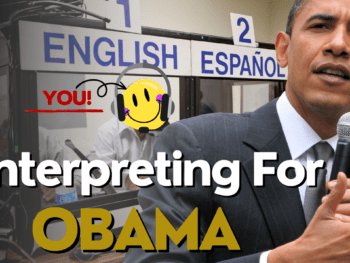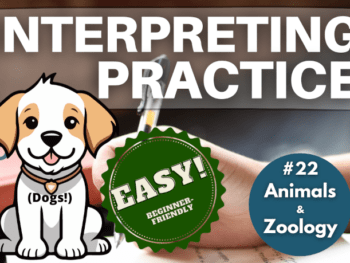Easy exercise for students who want to practice their consecutive or simultaneous interpreting skills. Note: The Speech starts STRAIGHT AWAY!
Topic(s): Animals, Zoology
Terms: coexist, wolves, canines, hunter-gatherers, packs, scavenging, symbiotic, scraps, prey, nomadic, natural selection, domestication, archaeological findings, symbiosis, mutual reliance, utilitarian, mythology, trainability, coevolution
Sources:
Also check these books to learn and practice interpreting.
Good For Practicing:
- Interpreting note-taking
- Consecutive Interpreting
- Simultaneous Interpreting
- Conference Interpreting
Level: Beginner
If you’ve found this post helpful or think it could be useful to a friend who perhaps is – or is planning to become – an interpreter, please kindly consider buying me a coffee by using the button below:
I put all my heart and soul into the content I produce in order to help my fellow linguists set foot in the industry. Most of what I do is available to everyone for free.
Donating is 100% optional, but greatly appreciated. A short espresso will do! ☕
Script:
The bond between humans and dogs started thousands of years ago, with a history based on mutual benefit and companionship. As two species that coexist in harmony, the journey from wolves to the lovable canines we share our homes with today is a fascinating tale of evolution and friendship.
The story begins when humans were still hunter-gatherers. Wolves, the ancestors of modern dogs, roamed freely, hunting in packs and scavenging for food. At some point, a symbiotic relationship emerged between early humans and wolves. The wolves that were less aggressive and more tolerant of human presence found themselves with a consistent source of food from the scraps left behind by humans.
Over time, this connection evolved beyond just coexistence. Humans began to recognize the advantages of having wolves as hunting companions. Wolves, with their keen senses, speed, and pack mentality, proved invaluable in tracking and bringing down prey. This collaboration increased the success of hunts, providing both species with sustenance and safety.
As humans transitioned from nomadic lifestyles to settled agricultural communities, the relationship with wolves deepened. The wolves that were more sociable and less aggressive were more likely to integrate into human communities. This natural selection process paved the way for the first steps of domestication.
The earliest evidence of intentional dog domestication dates back around 14,000 to 17,000 years ago. Archaeological findings suggest that humans played an active role in the breeding of wolves with specific traits, leading to the emergence of the first domesticated dogs. These early dogs served various roles, from hunting partners to guards and companions.
The symbiosis between humans and dogs continued to strengthen as both species benefited from the relationship. Dogs offered protection, assistance in hunting, and companionship. In return, humans provided dogs with a stable source of food, shelter, and care. This mutual reliance created a deep emotional connection, laying the foundation for the unique bond we share with dogs today.
Throughout history, dogs have held a special place in human societies worldwide. They became not just utilitarian partners but also symbolic figures in folklore, mythology, and religious beliefs. From ancient Egyptian mythology to Greek mythology, and so forth, dogs have left a definitive mark on human culture.
In the contemporary era, the role of dogs has expanded beyond utilitarian purposes. Dogs became family members, providing emotional support, unconditional love, and joy. Their keen senses and trainability have also led to their involvement in various roles, including therapy, search and rescue, and assistance for individuals with disabilities.
The story of how dogs became humans’ best friends is an extraordinary journey of coevolution and shared history. From the wild ancestors of today’s domestic dogs to the beloved companions we love so much, the bond between humans and dogs is a testament to the power of collaboration and friendship across species. As we continue to share our lives with these incredible creatures, the legacy of this unique relationship will surely endure for generations to come.














 Interpreting Training Exercise | The Indigenous Interpreters in South America
Interpreting Training Exercise | The Indigenous Interpreters in South America